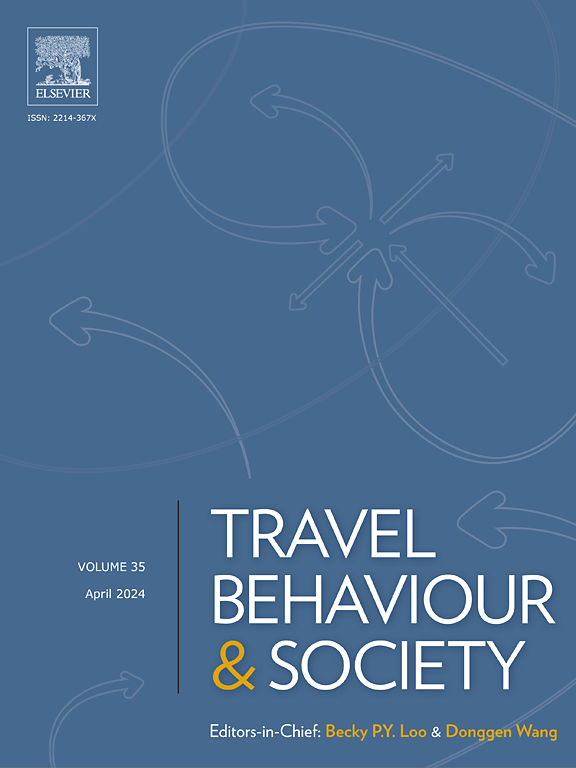加拿大时间使用调查中按模式进行的杂货店购物和相关访问旅行
IF 5.7
2区 工程技术
Q1 TRANSPORTATION
引用次数: 0
摘要
在旅行调查中,杂货店购物事件经常与其他购物事件分组,这使得研究这些活动变得困难。本文探讨了食品杂货购物旅行、购物事件特征和参与者,并评估了所有购物活动分组所产生的潜在信息损失。使用了2010年和2015年加拿大综合社会调查(第24和29周期)时间使用模块的大都市地区受访者数据样本。在2010年的调查中,杂货店购物和其他购物是分开调查的,而2015年的调查将所有的购物活动合并在一起。这提供了一个比较这些方法的机会。使用双变量检验和逻辑回归比较了2010年和2015年购物活动在参与、时间、店内活动时间和旅行持续时间、活动序列(店内活动与进出旅行)和受访者人口统计学方面的特征。在购物前和购物后分别用两个地点评估活动序列。杂货店购物活动序列的持续时间比其他购物活动序列短。性别和收入之间在购买食品杂货的时间上没有差异,而在其他购物方面则存在显著差异。“家-店-家”是所有购物类型中最常见的顺序。近一半的杂货店购物活动序列花费在入口和出口旅行上。在逻辑回归中,年龄、性别、就业和最频繁的旅行模式与购物行为有关,而与购物类型无关。与其他购物事件相比,杂货店购物与75岁或以上、已婚、来自少数族裔和受过高等教育的人联系更紧密。杂货购物活动在参与者、时间、持续时间和活动顺序等方面不同于其他购物活动。在未来的时间使用调查(以及旅行调查)中,将杂货店购物和其他购物结合起来可能会掩盖杂货店购物情节、旅行和整体顺序的独特性。本文章由计算机程序翻译,如有差异,请以英文原文为准。
Grocery shopping and related access trips by mode in Canadian time use surveys
Grocery shopping episodes are often grouped with other shopping in travel surveys, making it difficult to study these activities. This paper explores grocery shopping trips, shopping episode characteristics and participants, and assesses the potential loss of information stemming from the grouping of all shopping activities.
A sample of metropolitan area respondent data from the Canadian General Social Surveys’ 2010 and 2015 (cycles 24 and 29) time use modules is used. In the 2010 survey, grocery shopping and other shopping is surveyed separately, while the 2015 survey merges all shopping activities. This provides an opportunity to compare these approaches. The characteristics of shopping activities (2010 and 2015) with respect to participation, timing, in-store episode time and trip duration, activity sequences (in-store episodes with access/egress trips), and respondents’ demographics are compared using bivariate tests, and logistic regressions. Activity sequences are assessed using two locations before and two locations after shopping episodes.
Grocery shopping activity sequences are shorter in duration than other shopping activity sequences. No difference in episode duration is found between gender or income for groceries, while significant differences are found for other shopping. “Home-store-home” by car is the most frequent sequence for all shopping types. Nearly half of the grocery shopping activity sequence is spent on the access and egress trips.
In logistic regressions, age, gender, employment, and the most frequent travel mode are associated with having performed shopping episodes, regardless of shopping types. Compared to other shopping episodes, grocery shopping is more strongly associated with being 75 or older, being married, from visible minority groups, and with higher education.
Grocery shopping activities differ from other shopping in terms of participant, timing, duration, and activity sequence. Combining grocery shopping and other shopping in future time use surveys (and in travel surveys) may mask the distinctiveness of grocery shopping episodes, trips and overall sequences.
求助全文
通过发布文献求助,成功后即可免费获取论文全文。
去求助
来源期刊

Travel Behaviour and Society
TRANSPORTATION-
CiteScore
9.80
自引率
7.70%
发文量
109
期刊介绍:
Travel Behaviour and Society is an interdisciplinary journal publishing high-quality original papers which report leading edge research in theories, methodologies and applications concerning transportation issues and challenges which involve the social and spatial dimensions. In particular, it provides a discussion forum for major research in travel behaviour, transportation infrastructure, transportation and environmental issues, mobility and social sustainability, transportation geographic information systems (TGIS), transportation and quality of life, transportation data collection and analysis, etc.
 求助内容:
求助内容: 应助结果提醒方式:
应助结果提醒方式:


